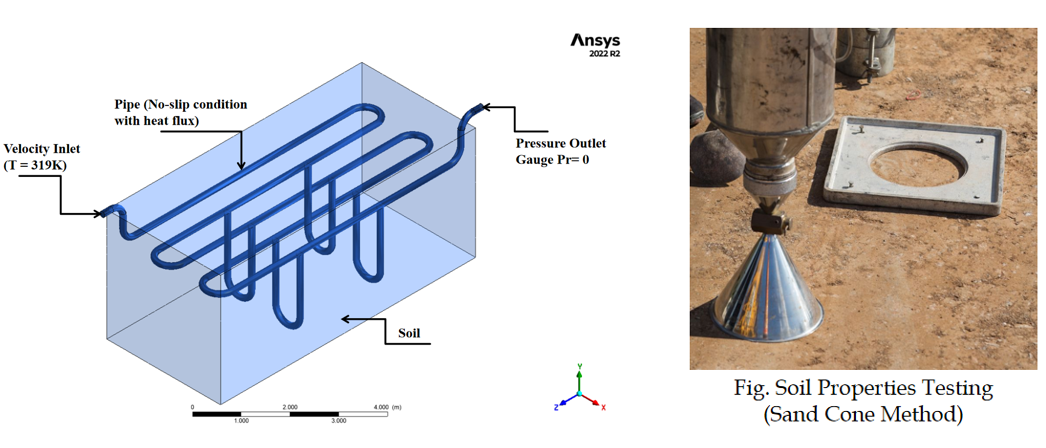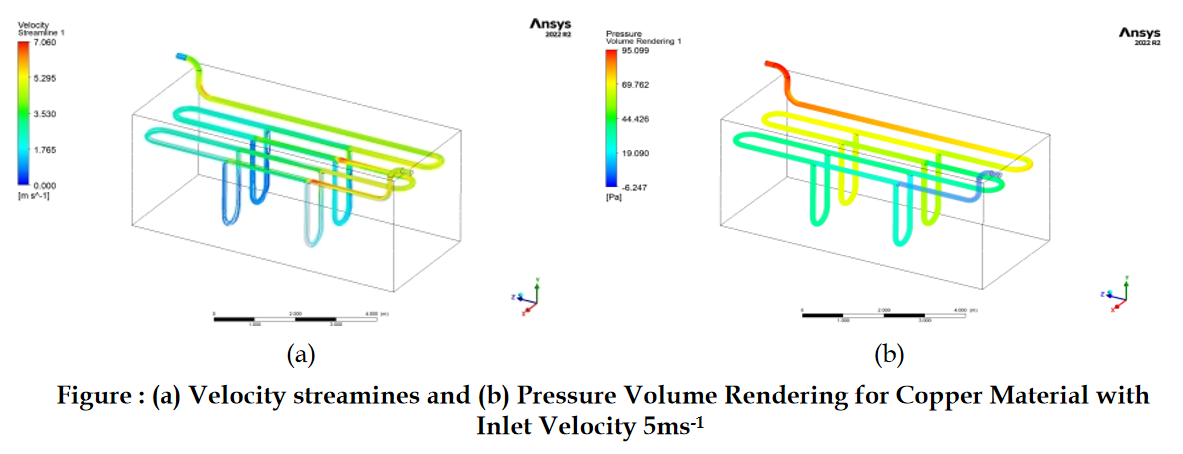
CFD-Based Performance Analysis and Optimization of Earth-Air Heat Exchanger.
Authors and Affiliation
Pranav Lohar, Chinmay Paradkar, Pratik Nirmal, Hrishikesh Desai & Ganesh Shete
School of Mechanical Engineering, MIT Academy of Engineering, Alandi, Pune.
Abstract
In the evolving landscape of sustainable energy solutions, Earth-Air Heat Exchangers (EAHEs) have emerged as vital contributors. This study focuses on the performance and design of EAHEs, using soil samples from Wardha district, Maharashtra, India, analyzed through Computational Fluid Dynamics (CFD). The results reveal exciting insights, particularly regarding material-specific performance. Copper demonstrates an impressive 24°C temperature drop in just 5 minutes at velocities of 3.5 and 5 m/s, while High-Density Polyethylene (HDPE) performs well with a 22°C drop in 10 minutes for smaller diameter pipe. These findings emphasize the potential of EAHEs for rapid and efficient heating and cooling applications. Beyond traditional HVAC practices, this research contributes to optimized configurations and enhanced thermal performance, making EAHEs integral in sustainable technology for various applications, from buildings to agriculture. This study provides valuable insights for advanced design strategies and operational guidelines, positioning EAHEs as pioneers in sustainable HVAC technology and paving the way for a more environmentally conscious future.
Methodology
To comprehensively analyze heat exchanger performance, a meticulous methodology is adopted. Firstly, the strategic selection of Aluminum, HDPE, and Copper as heat exchanger materials serves to highlight their diverse properties, including lightweight efficiency and corrosion resilience. Secondly, soil samples from Wardha district, Maharashtra, are tested for density and thermal conductivity using standardized methods. Lastly, Computational Fluid Dynamics (CFD) analyses conducted with ANSYS Fluent enable a detailed examination of the system's efficiency under various coil geometries, including a novel hybrid design, across a 55-meter pipeline.

Objectives
- What influence does changing the diameter of the EAHE have on its heat exchange performance and the overall cooling effectiveness?
- How does variation of flow rate from domestic exhaust systems affect on efficiency of EAHE?
- What are the material-specific effects on the EAHE system's efficiency, and how can the selection of materials be fine-tuned to maximize heat transfer and sustainability?
- To What Extent Does Computational Fluid Dynamics (CFD) Facilitate a Comprehensive Analysis of EAHE Parametric Variations, and How Can it be Leveraged for Informed Decision-Making?
Findings and Conclusion
In conclusion, this comprehensive research effort culminates in a nuanced perspective on material selection for Earth-Air Heat Exchanger (EAHE) systems, considering sustainability, efficiency, and cost-effectiveness. While each of the three materials, copper, aluminum, and high-density polyethylene (HDPE), has its distinct advantages, the context of their application is pivotal.

Sustainability Aspects:
- All three materials showcase their sustainability credentials. Copper and aluminum, though recyclable, are challenged by the environmental footprint associated with their mining and manufacturing processes.
- HDPE proves to be a reusable, cost-effective solution, offering favorable performance, especially at higher velocities. After 10 minutes, HDPE achieves ASHRAE compliance with an outlet temperature of 297 K.
Efficiency Considerations:
- Copper and aluminum, with their robust thermal conductivities, emerge as prime choices for optimized heat transfer efficiency.
- The results underscore the complex interplay between material properties, heat transfer mechanisms, and the governing laws of thermodynamics.
Key Findings:
- Copper's corrosion resistance and thermal conductivity make it an optimal material choice for heat exchangers.
- The utilization of Computational Fluid Dynamics (CFD) as a guiding force facilitates informed decision-making in material selection.
- A coil with a higher surface area-to-volume ratio, exemplified by the 15cm diameter coil, yields more efficient cooling.
- Higher velocities induce turbulence, enhancing the heat transfer coefficient and thereby improving system performance.
Post a comment